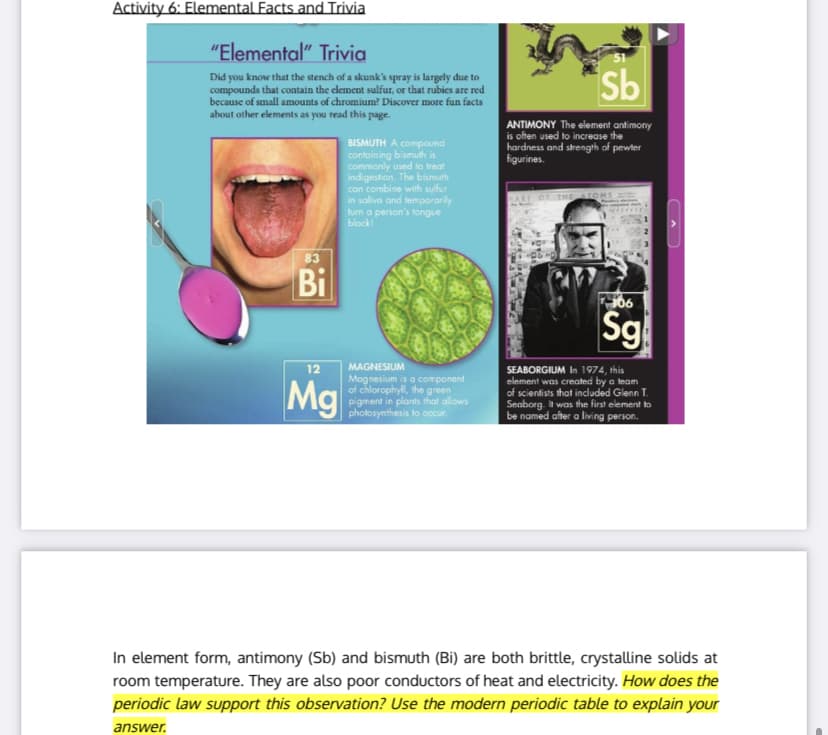In element form, antimony (Sb) and bismuth (Bi) are both brittle, crystalline solids at room temperature. They are also poor conductors of heat and electricity. How does the periodic law support this observation? Use the modern periodic table to explain your answer.
In element form, antimony (Sb) and bismuth (Bi) are both brittle, crystalline solids at room temperature. They are also poor conductors of heat and electricity. How does the periodic law support this observation? Use the modern periodic table to explain your answer.
Chemistry
10th Edition
ISBN:9781305957404
Author:Steven S. Zumdahl, Susan A. Zumdahl, Donald J. DeCoste
Publisher:Steven S. Zumdahl, Susan A. Zumdahl, Donald J. DeCoste
Chapter20: The Representative Elements
Section: Chapter Questions
Problem 23E
Related questions
Question
I could really use the help thank you!

Transcribed Image Text:Activity 6: Elemental Facts and Trivia
"Elemental" Trivia
51
Did you know that the stench of a skunk's spray is largely due to
compounds that contain the clement sulfur, or that rubies are red
because of small amounts of chromium? Discover more fun facts
about other elements as you read this page.
Sb
ANTIMONY The element antimony
is often used to increase the
hardness and strength of pewter
figurines.
BISMUTH A compound
contoining bismuth is
commonly used to treat
indigestion. The bismuth
can combine with sulfur
in saliva and temporarily
turn a person's fongue
black!
OF THE ATOMS
83
Bi
306
Sg
12
Mg
MAGNESIUM
Mognesium is a component
of chlorophyll, the green
pigment in plants that allows
photosynthesis to occur.
SEABORGIUM In 1974, this
element was created by a team
of scientists that included Glenn T.
Seaborg. t was the first element to
be named after a living person.
In element form, antimony (Sb) and bismuth (Bi) are both brittle, crystalline solids at
room temperature. They are also poor conductors of heat and electricity. How does the
periodic law support this observation? Use the modern periodic table to explain your
answer.
Expert Solution
This question has been solved!
Explore an expertly crafted, step-by-step solution for a thorough understanding of key concepts.
This is a popular solution!
Trending now
This is a popular solution!
Step by step
Solved in 2 steps

Knowledge Booster
Learn more about
Need a deep-dive on the concept behind this application? Look no further. Learn more about this topic, chemistry and related others by exploring similar questions and additional content below.Recommended textbooks for you

Chemistry
Chemistry
ISBN:
9781305957404
Author:
Steven S. Zumdahl, Susan A. Zumdahl, Donald J. DeCoste
Publisher:
Cengage Learning


Chemistry: An Atoms First Approach
Chemistry
ISBN:
9781305079243
Author:
Steven S. Zumdahl, Susan A. Zumdahl
Publisher:
Cengage Learning

Chemistry
Chemistry
ISBN:
9781305957404
Author:
Steven S. Zumdahl, Susan A. Zumdahl, Donald J. DeCoste
Publisher:
Cengage Learning


Chemistry: An Atoms First Approach
Chemistry
ISBN:
9781305079243
Author:
Steven S. Zumdahl, Susan A. Zumdahl
Publisher:
Cengage Learning

Chemistry by OpenStax (2015-05-04)
Chemistry
ISBN:
9781938168390
Author:
Klaus Theopold, Richard H Langley, Paul Flowers, William R. Robinson, Mark Blaser
Publisher:
OpenStax

Chemistry & Chemical Reactivity
Chemistry
ISBN:
9781133949640
Author:
John C. Kotz, Paul M. Treichel, John Townsend, David Treichel
Publisher:
Cengage Learning

Chemistry & Chemical Reactivity
Chemistry
ISBN:
9781337399074
Author:
John C. Kotz, Paul M. Treichel, John Townsend, David Treichel
Publisher:
Cengage Learning